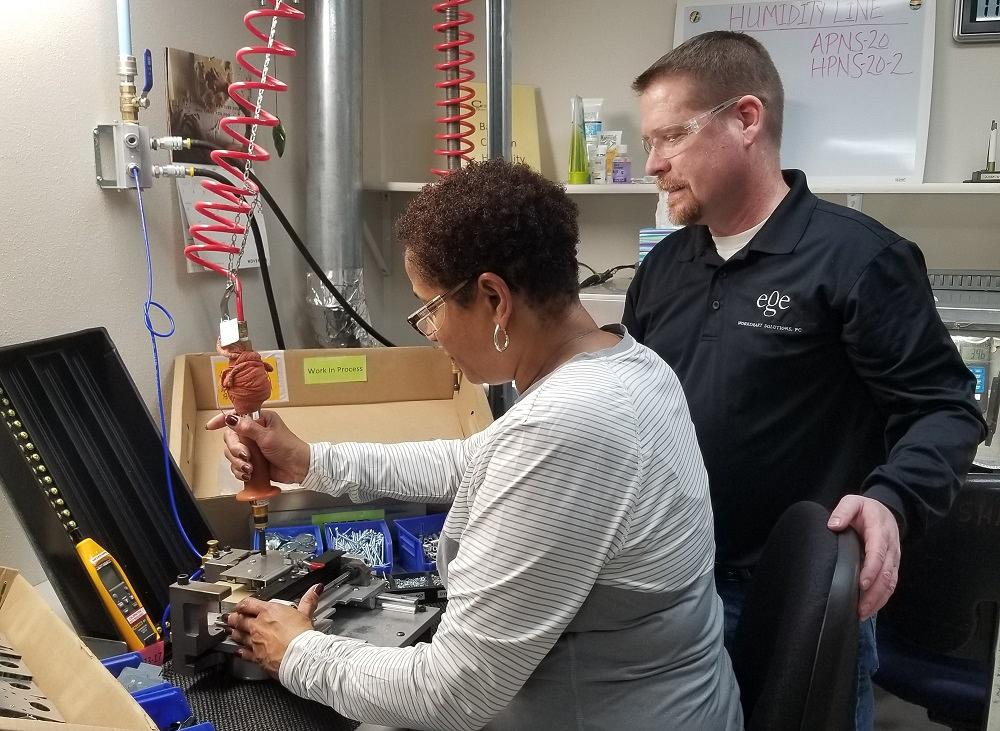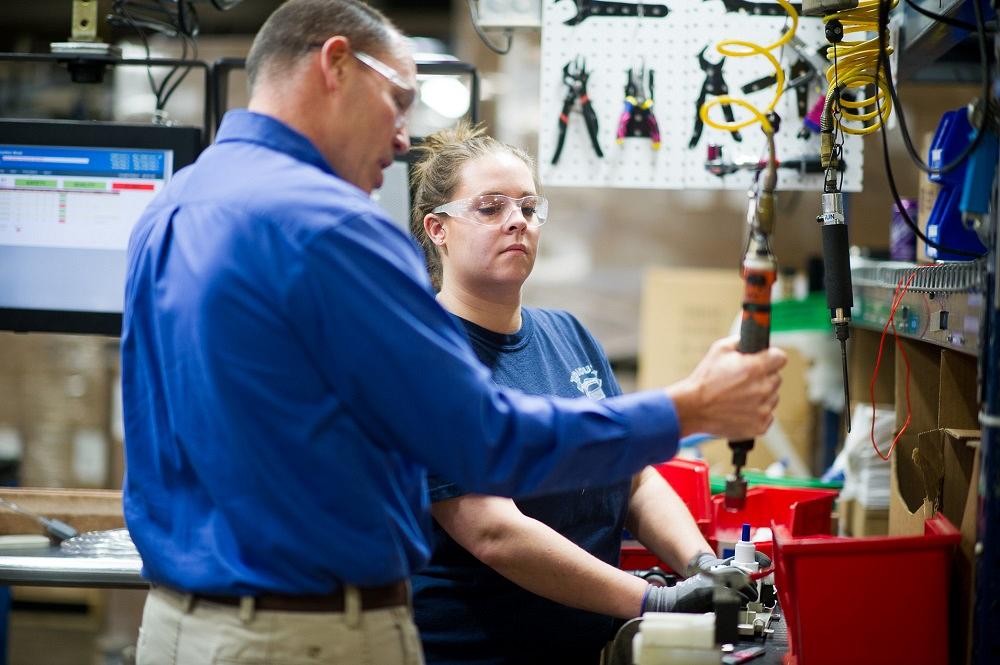Editor
- FMA
- The Fabricator
- FABTECH
- Canadian Metalworking
Categories
- Additive Manufacturing
- Aluminum Welding
- Arc Welding
- Assembly and Joining
- Automation and Robotics
- Bending and Forming
- Consumables
- Cutting and Weld Prep
- Electric Vehicles
- En Español
- Finishing
- Hydroforming
- Laser Cutting
- Laser Welding
- Machining
- Manufacturing Software
- Materials Handling
- Metals/Materials
- Oxyfuel Cutting
- Plasma Cutting
- Power Tools
- Punching and Other Holemaking
- Roll Forming
- Safety
- Sawing
- Shearing
- Shop Management
- Testing and Measuring
- Tube and Pipe Fabrication
- Tube and Pipe Production
- Waterjet Cutting
Industry Directory
Webcasts
Podcasts
FAB 40
Advertise
Subscribe
Account Login
Search
Prevent it, react to it, talk about it: Safety in the metal fabrication shop
Reducing workplace injuries requires multifaceted, all-hands approach for manufacturers
- By Lincoln Brunner
- August 9, 2022
- Article
- Safety

By listening to employees consistently, employers can detect the early warning signs of soft tissue injuries before they become reportable events. Ege Solutions
When Scott Ege began talking to companies about ergonomics and safety early in his physical therapy career, he thought a little prevention advice would change workers’ behavior.
Ege, owner and founder of musculoskeletal health firm Ege Solutions in Rockford, Ill., would bring some weights and a model of a spine to a lunchtime talk and demonstrate proper lifting and movement. People would even say how great they thought his demonstration was.
“But it didn’t change behavior,” Ege said. “[I thought], ‘Once you see how to do it, you’ll go do it.’ And that just doesn’t happen.”
So, what can positively change the way people work? How does a metal fabrication shop improve ergonomics in a way that reduces workplace injuries while increasing both productivity and workers’ quality of life? According to Ege, it takes a combination of measures—reacting early to worker complaints, dispelling inaccurate beliefs about safety, and talking with employees often about their work environment.
The Numbers
The stakes are high in the ergonomics game.
According to one study, soft-tissue injuries account for 33% of workplace injuries in the U.S. but 80% of the workers’ compensation costs.
Those are real dollars out of the pockets of employers and their insurers, but it doesn’t paint the whole picture. One of Ege’s clients pegs the direct cost of musculoskeletal injury at $15,000 per incident but calculates the indirect costs at four times that—for a total of $75,000.
And that still doesn’t factor in how much more productive a company must be to cover that initial hit. Another Ege client, a warehousing company, estimated that it had to move 3,000 to 4,000 additional boxes a year to cover the costs of just one musculoskeletal injury.
Be Reactive, not Resistant
So, what do businesses and their employees do to avoid those losses? No one can prevent all stress-related injuries, but reacting to the early warning signs of soft-tissue injury, when someone is feeling mere discomfort, makes the difference between a small adjustment and an OSHA-reportable injury.
The key for both the employees themselves and their supervisors (or safety officers) is to pay close attention to the early warning signs—for example, fatigue, soreness, and muscle tightness—so that they don’t lead to real injury.

When everyone in the operation is working on better ergonomic practices and knows that management cares about protecting their health, everyone gains an advantage.
There’s just one problem: human nature. After 30 years in the field, Ege has derived two immutable truths about workers and their tendencies:
- People will not speak up about their pain until it clearly limits their ability to function.
- When they hit that point, they will want the quickest fix possible.
“When that pain progresses from discomfort and soreness to eventually some level of pain and limited function—I can’t do this task or I can’t bend over this way or use my arm that way or pick something up a certain way without severe pain—that’s when they actually think that they’ve got an injury,” Ege said. “The progression has been going on for weeks, if not months or years [leading] up to that.
“So, as a result, when people do have the injury, they show up to the health and safety professional saying, ‘Hey, this is what’s going on,’ and they’re way down the line in terms of injury progression,” he said. “They come to a health care provider … and they say, ‘Hey, my shoulder’s really killing me. I can’t sleep on it at night. I can hardly raise my arm up. Can you give me something quick? Do I just take some ice or ibuprofen and it will get better?’”
Whereas injured workers often believe they are safe before they experience severe pain, what people know from years of ergonomics research is that extended reaching, bending, and twisting in awkward postures and with excessive force puts people at huge risk for soft-tissue injuries, Ege noted. But, because people don’t see themselves doing those things and because they’re not in pain, they think they’re safe. That is until, metaphorically speaking, they come in with smoke pouring out of their engine hoping that an oil change will fix things, when in fact the time for the oil change came and went a long time ago.
Unfortunately, what often adds fuel to that fire is their employer’s unwillingness to change the person’s work environment, even though the employee suffered an OSHA-reportable injury.
“It’s almost like there’s resistance,” Ege said. “It’s almost like [willful] ignorance: ‘I’m going to ignore you. I’m just going to hope you go away. I’m going to hold my breath and hope this gets better over the next couple of days.’”
Clearly there’s a better way. However, convincing employees and employers to take proper safety precautions—especially if they have never experienced pain that interrupted their work or they think proper lifting and moving slows their work too much—is a tall order.
However, incentives abound for both parties, and achieving a win-win for everyone is possible, Ege believes.
Making Ergonomics a Win-Win
Employees. In Ege’s experience, many workers carry two misconceptions—that they’re too old to improve their health and that changing the way they work isn’t worth the effort. Both are false.
“The millennial generation, they’re much more health-conscious,” Ege said. “They want to be healthier. Our older workforce thinks, ‘Hey man, my ship has sailed a long time ago. You can’t make me healthy. I’ve been worn down. You’ll have to work with the younger people.’ And that’s not true. The reality of it is, we can still change behavior.

Taking the time to review proper ergonomic handling of tools and loads communicates to a workforce that management cares about everyone’s wellbeing, not just the bottom line. Ironically enough, the bottom line always benefits when workers stay healthy and productive.
“Workers are always subconsciously asking ‘What’s in it for me? Is this going to help me or is this going to hurt me?’”
To that end, here are some common-sense safety steps employees can take right now, based on Ege’s research and well-known general health tips:
- Stay well-hydrated by drinking at least 80 oz. of water a day. Dehydration leads to tight muscles and tendons, which makes them more prone to injury.
- Respect basic principles of movement:
- Carry items close to your body.
- Keep your elbows in, close to your core.
- Stay centered by keeping your head above your shoulders and your shoulders above your hips.
- Use a wide base of support by keeping your feet spread wide.
“We’re able to identify that it results in 40 percent less engagement of back muscles when they use these proper techniques,” Ege said. “It sounds great from a research standpoint, but what that means to the worker is actually that you could potentially, if you use these strategies, go home with 40 percent more gas in your tank.”
That means better rest, better recovery from long days of work, and more energy all around—in short, better quality of life.
Employers. For business owners, the economic advantages of keeping people healthy and working, staving off OSHA-reportable injuries, and boosting productivity in the process should be incentive enough. But for those who may perceive recommended safety and ergonomic measures as too onerous, Ege has good news.
“I try to challenge workers: If you went home without pain and soreness and discomfort, what would your life be like?” Ege said. “Well, the employer needs to look at that as well. I mean, we see employers with good ergonomic strategies, good health strategies, stretching or other types of initiatives, they could easily get a 3-, 4-, 5-, or 7-to-1 return on their investment. We see that routinely across the board with our client companies. That's a win for the employer, and that is certainly a win for the employee. That's what you're trying to do—set yourself up for that kind of success.”
Create a Communicative Environment
Finally, helping employees feel free to share their concerns and ideas boosts morale and can increase workplace safety dramatically.
“Start talking about it,” Ege said. “It's creating this environment where employees feel that supervisors and management want to hear what their concerns are about the safety related to their job. ‘Tell me more about that’—that's a great phrase. Engagement is a huge metric that I think employers are looking at in lots of aspects of work.
“I think employees probably are some of the best ergonomists in any company,” he said. “They come up with all kinds of creative ways to make things easier for their bodies, but they don’t necessarily think about how that might benefit somebody else. So, I think [it’s about] creating this environment where there’s open exchange of information and a platform that’s intentional around getting that information.”
About the Author

Lincoln Brunner
2135 Point Blvd.
Elgin, IL 60123
(815)-227-8243
Lincoln Brunner is editor of The Tube & Pipe Journal. This is his second stint at TPJ, where he served as an editor for two years before helping launch thefabricator.com as FMA's first web content manager. After that very rewarding experience, he worked for 17 years as an international journalist and communications director in the nonprofit sector. He is a published author and has written extensively about all facets of the metal fabrication industry.
About the Publication
subscribe now

The Tube and Pipe Journal became the first magazine dedicated to serving the metal tube and pipe industry in 1990. Today, it remains the only North American publication devoted to this industry, and it has become the most trusted source of information for tube and pipe professionals.
start your free subscription- Stay connected from anywhere

Easily access valuable industry resources now with full access to the digital edition of The Fabricator.

Easily access valuable industry resources now with full access to the digital edition of The Welder.

Easily access valuable industry resources now with full access to the digital edition of The Tube and Pipe Journal.
- Podcasting
- Podcast:
- The Fabricator Podcast
- Published:
- 04/16/2024
- Running Time:
- 63:29
In this episode of The Fabricator Podcast, Caleb Chamberlain, co-founder and CEO of OSH Cut, discusses his company’s...
- Trending Articles
Team Industries names director of advanced technology and manufacturing

Orbital tube welding webinar to be held April 23

Chain hoist offers 60-ft. remote control range

Push-feeding saw station cuts nonferrous metals

Corrosion-inhibiting coating can be peeled off after use

- Industry Events
16th Annual Safety Conference
- April 30 - May 1, 2024
- Elgin,
Pipe and Tube Conference
- May 21 - 22, 2024
- Omaha, NE
World-Class Roll Forming Workshop
- June 5 - 6, 2024
- Louisville, KY
Advanced Laser Application Workshop
- June 25 - 27, 2024
- Novi, MI


























